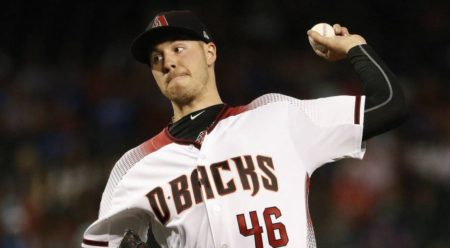The Delicate Art of Hot Stove Baseball Calisthenics
 Calisthenics
Calisthenics
Defined as gymnastic exercises to achieve bodily fitness and grace of movement, are we witnessing the equivalent of baseball calisthenics this offseason?
Teams adopting unusual postures to gracefully stretch their bodies in just the right direction so they can react when a desired player swings past?
There are so many players to consider. And so many calisthenic exercises to choose from. Players under contract. Free agents. Minor leaguers. So, why are only a relatively few players mentioned over and over? Why are all these teams competing to lure the same player?
There are thousands of players in the baseball leagues spread around the world, and the same 50 players are mentioned repeatedly in papers and television.
Statistically, position players are expected to repeat the numbers on the back of their baseball cards every year. They are who their cards say they are. Teams are purchasing their historical production. Known quantities.
But since pitchers, especially, are so volatile and do not repeat the back of their baseball cards regularly, pursuing pitching is a much more delicate matter.
The Yankees …
They are seeking another pitcher after adding James Paxton in a trade with Seattle earlier this offseason. But should they really be thinking about spending more than $100 million on a free agent like Patrick Corbin? Is he that good? That reliable? Reports assert he is no better than a number three starter. Is Corbin that much better than a younger pitcher in someone else’s minor league system who might be worth a flyer in the majors for half a million dollars a season? This whole season of calisthenics is about stretching and bending and deciding which players fit best. But it has to be delicately employed.
Jordan Montgomery will not be ready to return until mid-season, and last year’s rookie replacements, Domingo German and Jonathan Loaisiga, inspired only so much confidence, so the need for a more reliable replacement who would keep the Yankees in the game until their powerful offense explodes, seems a reasonable idea. But for more than $100 million?
While only the Yankees know how much money they earned last season, it’s fair to guess that with all their moving parts: the players, attendance, beer sales, parking, merchandise sales, licensing revenues from the businesses operating inside Yankee stadium, and perhaps the largest slice of their pie, the television revenues from YES, it’s reasonable to assume the Yankees provided the Steinbrenner family an attractive return on investment. And 2018 was a season the Yankees did not make the World Series. So the question is, would Patrick Corbin or any other pitcher really be worth it? Would he put the Yankees in the Series?
Granted, the Yankees earn far more money than the Tampa Bay Rays, and they can easily afford a pitcher like Patrick Corbin or any other, but it’s hard to believe there are not several obtainable pitchers in the minor leagues who could help them.
… Compared to The Tampa Bay Rays
Tampa Bay would find that player. This past season they plugged in solid relief pitchers acquired from different organizations and used them as starters. “Openers.” They barely spent a fraction of $100 million for these pitchers who scared opponents with their assortment of pitches. And the Rays added to the distress by following up their openers with a righty after a lefty, a soft-tosser after a flamethrower, all of whom defied hitters. No wonder few teams were able to mount a consistent attack against this pitching strategy.
So, this said, is Patrick Corbin the $100 million choice? Or would the Yankees do better to throw pitchers like Chad Green and Dellin Betances 125 to 150 innings a season, rather than 50 to 75 innings? Since Corbin may only throw 175 to 200 innings (he threw 200 innings in 2018), if Betances and Green threw 50 more innings each, that would be 100 of the 200 innings that Corbin could provide. Half. And would not cost $50 million. Green and Betances could occasionally “open” games, and allow the Yankees to bring up any of their other younger pitchers deemed ready for the majors.
Like the young right-hander Michael King, whom they acquired from Miami in the Caleb Smith deal. He was prominently discussed around the trade deadline when it was reported teams asked about his availability before anyone else in Yankeeland.
But the real problem is if the Yankees or any other team chooses the inexpensive route and it does not work, then they will be second-guessed in the press. The New York press. Not for the squeamish. And second-guessing is embarrassing, since hindsight’s always 100 percent. Even in Tampa Bay.
So, teams are bending and stretching as they consider just how fit they’ll need to be to entice a better caliber player. Can they really reach behind and grab Manny Machado as they do their deep knee squats? Only if they practice their baseball calisthenics.
Another Question
Why does anyone want 36-year-old Robinson Cano? Even packaged with Seattle’s best relief pitcher Edwin Diaz? But if money is more available in baseball than quality talent, it makes sense to pay all of Cano’s remaining $120 million salary to secure the next three or four years of Diaz’s quality pre-free agency services at severely discounted talent prices.
But why would the New York Mets, the supposed front-runner now, want this deal? Especially when they are supposedly offering Seattle some of their best young talent as they pay the freight for Cano. Why offer top young talent if they’re paying the freight? Why not just pay the freight and offer minimal talent?
Why not?
Because the Mets have not been free spenders over the past decade, since the Wilpon’s lost hundreds of millions (if not billions) during the Madoff scandal. The Mets are an example of the failure of baseball calisthenics.
It’s pretty clear Diaz will not put this rag-tag bunch over the top. Highly unlikely. The Mets lack enough championship talent. So, if only the Mets could rid themselves of the unproductive Jay Bruce and simply awful Anthony Swarzak (who should never have been signed to a free agent contract in the first place) along with a medium prospect for Edwin Diaz and Robinson Cano, the deal would be palatable. But not the way it sits now.
It’s yet another example of an organization without a clue making an abysmal move. Baseball calisthenics turned upside down. Right now, it’s worse than the wrong decision. Winning teams need closers. Not mediocre ones, like the Mets.
Winning teams need five-tool players, like Jerred Kelenic, and up-and-coming pitchers, like Justin Dunn. They don’t trade them just like that. They don’t trade them just to say they made a trade.
See?
And if they do, they don’t acquire 36-year-old, over-the-hill steroid abusers like Robinson Cano, with five years left on a bloated contract. That’s losing baseball.
Had the Mets hired Chaim Bloom as their General Manager, this sort of a deal would never have been considered. It’s folly. It’s hard to see the deal, if it goes through as reported, making the Mets’ a championship contender. More than likely it will weaken them by robbing two young assets who could be pivotal pieces on an improved team in three years.
So, Why do the Deal?
Wouldn’t the Mets be better off with an up-and-coming minor league pitching star (assuming they could find him?) and their two blue-chip talents still on the team in three years? It’s certainly a defensible argument. Bloom would probably think this way as well.
But baseball calisthenics are sexier. Public. And make it seem as if the Mets can touch their backs while balancing a glass of water on their index finger, until the glass falls and breaks, spilling all the liquid and spraining their finger. It’s only a matter of time.
So, if a team is going into the gym to ready themselves for the coming season, they had better pay close attention to their own musculature lest their physiognomy seem as wretched as the player transaction they have pulled off.
Baseball calisthenics matter.

























